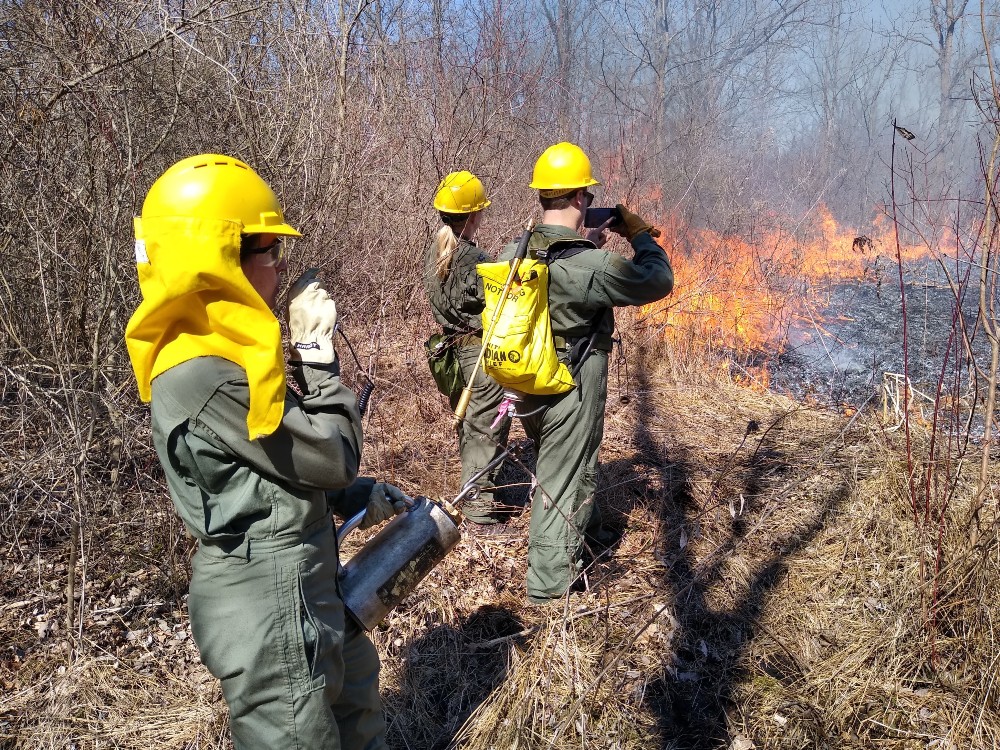Humans have a complicated relationship with fire. For our ancestors, it increased waking hours, changed the essence of food preparation, and brought light to dark corners of the world. Even now, it is fundamental for industry, daily life, and divinity.
But when it comes to nature, firelight seems to have a dark side. It is easy to conjure images of wildfires devouring forests. While the increasing number and intensity of wildfires in the West is a dire concern, fire itself is part of a critical cycle that increases the health and resilience of ecosystems.
Despite our interpretation of destruction, burning our grasslands is one of the best ways to help unique prairie plants flourish. Much like doctors prescribe medicine to improve our health, land managers carry out prescribed burns to maintain and restore the health of prairie landscapes.
What makes a prairie special?
A prairie is land made up of warm season grasses and wildflowers. Though prairies may look open and spacious, there is a staggering amount of plant and wildlife diversity. Imagine standing in a grassland. Within arms’ reach, you could touch 20-30 different types of plants in a high quality prairie. Not even the most extravagant bouquet has such diversity at your fingertips!
The fuchsia pops of Ironweed, golden circlets of Compass Plant, lavender colored cups of Beebalm, and colossal Big Bluestem grass makes looking at a prairie magnificent (and standing in a prairie a little intimidating…).
Wildlife abounds in this habitat. Mammals, amphibians, reptiles, and hundreds of species of birds all rely and flourish on the fertile plains.
Prairies once covered North America, but now are one of the rarest ecosystems. Before settlement, 15 percent of Indiana was prairie, mostly in northwest and west central portions of the state. But, nearly all prairie ecosystems have been lost to farmland. Those that you see in east central Indiana are most often planted, restored prairies.
How does fire benefit a prairie?
Of the hundreds of types of plants found in prairies one should not be found– trees.
Forests are lovable and in need of preservation and growth in our area. But, they do not belong in grasslands. The nutrients, water, and sunlight needed by a tree disturbs the balanced prairie ecosystem.
The grasses and flowering plants in prairies have deep root systems, with some up to 15 feet below the surface. The thick mat of deep roots is a vice grip, but every so often a prolific, enterprising tree will start to grow.
So, what keeps prairies from turning into forests? Fire.
Fire kills plants that are not specifically adapted. Usually, plants with bark do not survive a fire. When fire passes over the ground, the non-prairie plants are eradicated.
Removing standing plants is another important effect. Once the standing plant material is cleared, sunlight can warm the surface of the ground. Black ash absorbs the sun’s heat during the day and insulates soil from cold nights. This warming speeds up the growth of new plants. And, once the new sprouts are above ground, there is readily available sunlight needed to photosynthesize and make plant food.
Additionally, plants that still tower over the ground intercept rainfall and dew. With them gone, moisture can reach the ground for new plants. Nutrients that were stored in the plant material that was burned is cycled back into the soil. .
How do prairie plants survive a fire?
Prairie plants are specially adapted to grow quickly after being burned. The part of the plant that triggers growth of new shoots, the meristem, is below the ground. Grasses are efficient fuel, making the fire fast-moving. When fire passes, the soil’s surface can be more than 600 degrees Celsius (1112 degrees Fahrenheit), while only 1 cm below the surface the temperature has not changed. The meristem stays unaffected by the heat and ready to grow new plants.
A prairie plant’s deep root system provides moisture and nutrients which give the young plant easy access to necessary resources.
What is a prescribed burn?
Prairies maintaining tree-less status through fire is not new. Historically, lightning was the primary cause.
Controlled and planned fires mimic nature. They are designed by a team of certified specialists. The strategy includes making sure the fire takes place under the safest conditions considering factors like wind, temperature, humidity, time of day, and season. Very specific methods are used to make sure the direction of the fire and extent of the burned area is precise.
Most controlled fires take place in late-March into April. That avoids damage to early blooming wildflowers and nesting seasons. Often, ecological thinning and on-foot survey takes place beforehand.
Each prairie has a unique management plan. Planned burns can be as frequent as every year, but a 3-5 year cycle is common.
Using fire to manage a prairie is an invigorating and necessary tool to make sure it stays fertile and biodiverse. Through careful consideration, planning, and strategy, land managers can imitate nature’s maintenance techniques preserving the integrity of a grassland ecosystem while keeping our community safe.
Kelley V. Phillips is the Communications & Outreach Manager for Red-tail Land Conservancy. She strives to cultivate wonder in nature and action to protect it.




